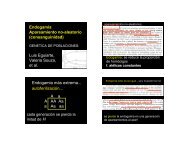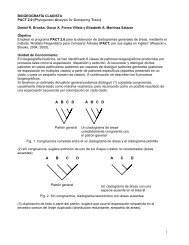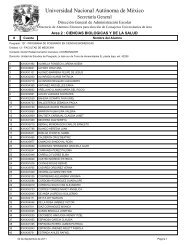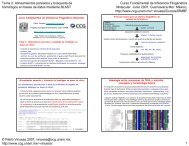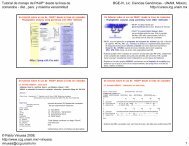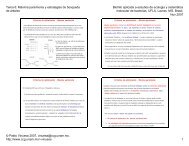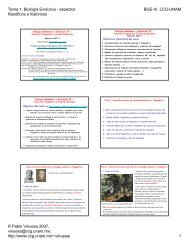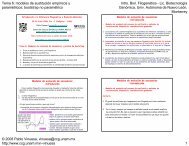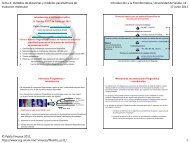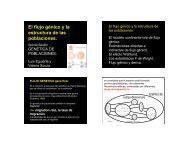<strong>Chromosome</strong> <strong>Structure</strong>binds RNA. Although HU shows a preference forstructurally ‘bendable’ sequences, it binds DNA relativelynonspecifically, forming complexes that stabilize negativesupercoils in double-stranded DNA (Figure 1). In phage Mutransposition reactions, HU binds to a flexed DNAstructure called a transpososome with high affinity andspecificity.H-NS is a second relatively nonspecific DNA-bindingprotein that forms dimers, tetramers and possibly higherorderassociations when bound to DNA. Like HU, H-NSconstrains negative supercoils. H-NS binds ‘bendable’DNA, which include AT-rich sequences often found nearbacterial promoters; H-NS also modulates the transcriptionofnumerous operons in E. coli and oflysogenicphages.FIS protein forms homodimers and binds DNA atspecific sites. FIS was discovered nearly simultaneously intwo related site-specific recombination systems: the Hininversion reaction of Salmonella typhimurium and the Gininversion reaction ofphage Mu. FIS concentration rises inearly log phase when the protein has regulatory roles inreplication initiation at oriC and transcription ofribosomalRNA operons, and then FIS abundance declines instationary phase.IHF protein is composed oftwo subunits (encoded bythe himA and hip genes) that are about 100 amino acidslong and which make stable heterodimers. IHF proteinbinds to a consensus sequence that was first discovered inphage l, where it stimulates insertional and excisionalrecombination in vitro by a factor of 10 4 . IHF bends DNAseverely (more than 908); such bends are critical for sitespecificrecombination in l, for repression and activationofphage Mu, and for repression–activation in a number ofcellular operons, including ilv, oxyR and nifA.In the eukaryotic nucleus, enzymes such as RNApolymerase gain access to DNA, which remains histonebound throughout most biochemical transactions. Theway in which multiple proteins interact with nucleosomecoatedDNA is not completely understood; however,protein access to DNA is modulated by histone structure.Histone phosphorylation and acetylation change chromatinstructure. Genes that are transcribed contain nucleosomeswith acetylated subunits ofhistones H3 and H4,whereas inactive genes are bound by histones lackingactetyl groups. In addition to the histones, eukaryoticchromosomes contain regulatory proteins that are muchless abundant. One class ofproteins, the high mobilitygroup (HMG) family of DNA-binding proteins, bendsDNA much like bacterial proteins IHF and FIS.DNA ReplicationThe central problem in chromosome replication isgenerating two high-fidelity DNA copies and distributingthem precisely to compartments that become the daughtercells. To control chromosomal replication temporally, andto integrate DNA metabolism with other aspects ofthe cellgrowth such as membrane synthesis and cell wall expansion,E. coli makes a master regulator, the DnaA protein,which controls the onset ofreplication at a site called oriC.The bacterial replication cycle can be described byprogression through four stages. Less detail is available foreukaryotes, but many points are similar. As cells grow, themass ofprotein and membrane increases to a critical pointthat triggers the initiation ofreplication. Two replisomesare associated in a ‘factory’ that moves to the cell centreduring chromosomal elongation. As DNA strands arepulled to the centre, replicated sister chromosomes migratetoward opposite cell poles. Completion ofDNA synthesisoccurs as the DNA that is pulled into the factory reachesthe terminus. At this point, chromosomes are tangledtogether (catenated), and all physical connections must beremoved to allow final separation. When physical separationis complete, cell wall synthesis forms two daughtercells.InitiationDNA replication starts at oriC near position 2 85 ofthestandard E. coli genetic map (Figure 2). Initiation involvesthe DnaA protein-assisted assembly oftwo replisomes,each dedicated to replicate halfa chromosome. Replisomecomponents include: the DnaB helicase, which is an ATPdependentring that moves along a single strand breakingopen the double helix for polymerase access; a dimericDNA polymerase molecule with accessory cofactors; and acomplex called the primosome that triggers RNA-primedinitiation ofnew DNA strands on one side ofthe growingfork. Each replisome has a pair of polymerase subunits:one synthesizes DNA continuously along the strand with5’–3’ polarity, and the other subunit synthesizes DNAdiscontinuously in small fragments called Okazaki pieces.Thus DNA replication is semidiscontinuous.In eukaryotic replication, initiation steps are not as fullyunderstood as they are in E. coli. Initiation occurs at arssites, so called because they are autonomously replicatingsequences (Figure 3). Initiation is controlled by a group ofproteins called ORC (origin replication complex). Typically,a chromosome has many ORC-binding sites, andbidirectional semidiscontinuous forks move out fromseveral ars sites on each chromosome until they convergewith other forks. Eukaryotic replication also occurs in‘factories’, and most of the chromosome is replicated in asemiconservative and semidiscontinuous mode, as in E.coli. The eukaryotic replication fork behaves very similarlyto that found in E. coli.4 ENCYCLOPEDIA OF LIFE SCIENCES / & 2001 Macmillan Publishers Ltd, Nature Publishing Group / www.els.net
<strong>Chromosome</strong> <strong>Structure</strong>Continuous strandSemiconservative andsemidiscontinuous replication(a)Discontinuous strandReplisomeEscherichia coli replicationReplichore IReplichore IoriCoriCE. coliWatson strand templateterEE. coliCrick strand templateReplichore IIterFterDterAterCterBdifReplichore II(b)Figure 2 (a) A replication fork is shown with a replisome as a blue box, moving and synthesizing DNA from left to right. Replication is semiconservative,meaning that a new strand is synthesized on each of the two parental template strands, and semidiscontinuous, meaning that the strand that followsthe fork with 5’ to 3’ polarity is made as one continuous piece while the strand that follows with overall 3’ to 5’ polarity is made discontinuously as Okazakipieces. (b) The two circular chromosomes show the products of bidirectional replication. Initiation starts at oriC ( 2 85) and proceeds clockwise in thezone called replichore I and counterclockwise through the zone called replichore II. Replication forks meet at a terminus near the dif site ( 2 34). Strandsmade in the continuous mode are shown in red, and discontinuous strands in blue. Also included in the map are the seven ribosomal RNA operons(arrowheads), five of which reside in replichore I and two of which are found in replichore II, six ter sites and the dif site. Note that the two daughters aresynthesized with different semidiscontinuous styles in replichores II and I so that the Watson and Crick strands are isomers.ElongationAfter initiation, duplication of the entire 4.6-Mbp E. colichromosome takes 40 min. One replisome copies DNA inthe clockwise direction (replichore I), while the otherreplisome copies DNA counterclockwise (replichore II)(Figure 2). DNA polymerase synthesizes new strands at astaggering rate of300 nucleotides per second. Replicationis semiconservative, meaning that one newly synthesizedstrand is made to match each parental template. BecauseDNA polymerases synthesize DNA only in the 5’ to 3’direction, and because replication forks copy bothtemplates at nearly the same time, there is asymmetry inthe mechanism ofchain growth. One strand is made as asingle piece while the other strand is synthesized in a seriesof1-kb segments, with each segment being initiated with asmall RNA molecule. These are called Okazaki pieces, andthey are stitched together after removal of the RNAprimers. This semidiscontinuous pattern ofDNA replicationis a recurring theme in organisms as diverse as plantsand humans.Because replication is semidiscontinuous, the sisterchromosomes (shown at the bottom of Figure 2) arereplication isomers. The template strand with 5’ to 3’polarity in the clockwise direction (the Watson strandtemplate in Figure 2) always contains DNA replichore I,which is made discontinuously, and DNA replichore II,which is made continuously; the Crick strand templatealways has the opposite style. Mutation and recombinationrates differ between discontinuous and continuousreplication modes, so the sisters are not always equivalent.As replication proceeds, positive supercoils build up infront of the fork, and the daughter chromosomes becomeentangled behind the fork (Figure 4). These two topologicalproblems are solved in similar ways in the two kingdoms.For E. coli, DNA gyrase removes positive supercoils aheadofthe fork, and TopoIV removes the links between thedaughter chromosomes, which are called catenanes.Eukaryotic TopoI eliminates the positive supercoilsformed ahead of the fork, and TopoII decatenates thechromosomes for segregation (Figure 4).ENCYCLOPEDIA OF LIFE SCIENCES / & 2001 Macmillan Publishers Ltd, Nature Publishing Group / www.els.net5



